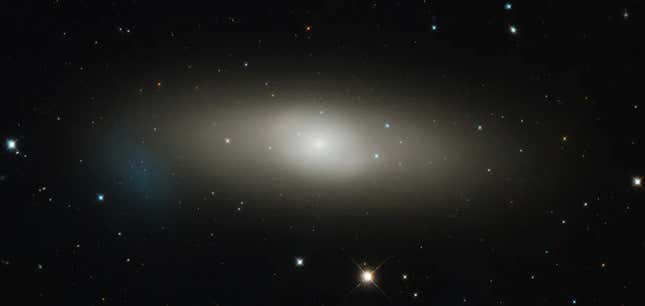It looks a bit like a boat, or a stout fedora. So what the hell is this rusty brown gossamer of a space cloud?
If we’re being perfectly specific, it’s the lenticular galaxy NGC 4753, which sits about 60 million light-years from Earth in the constellation Virgo. The above image was snapped by the NASA/ESA Hubble Space Telescope; the telescope views the galaxy nearly edge-on, meaning we are observing it from the side, across its diameter, rather than from above, which would reveal its full structure.
Lenticular clouds are elliptical—on Earth as they are in heaven. Fittingly lenticular clouds sometimes get compared to, or even mistaken for, flying saucers. After all, they’re pretty alien compared to our normal, fluffy cumulus clouds.
Lenticular galaxies have poorly defined spiral arms, making them look more like oblong blobs than the classic whirlpool swirls of spiral galaxies. In case you were at risk of losing your sense of scale, NGC 4753 is part of a cloud in the constellation Virgo that is made up of about 100 galaxies and galaxy clusters. The universe is a big, big place, and this lenticular galaxy is just a gas station on one of the universe’s feeder roads.
NGC 4753 is thought to be the result of a galactic merger, between itself and a dwarf galaxy some 1.3 billion years ago. The crispy brown lines of dust seen in the image probably took shape due to the merger, according to a NASA release.
The new image of the galaxy is the sharpest view of it yet, dating back to its discovery in 1784. Most of the galaxy’s mass is locked away in a dark matter halo, according to the same release, meaning that it cannot be imaged and its presence is only detected by its gravitational effects on visible matter. Most galaxies contain dark matter, as it comprises about 85% of all the universe’s matter, though some appear not to.

Dark matter is also at play in gravitational lensing, a phenomenon which magnifies regions of space time, allowing astronomers to image very distant and faint objects they would otherwise have difficulty with. The Hubble and Webb Space Telescopes can image the same regions of space to illuminate objects across a broader range of the electromagnetic spectrum, helping scientists refine dark matter models and characteristics of those objects.
The lenticular galaxy NGC 4753 might challenge your preconceptions about typical galactic forms, but it’s just one example of the diversity among the 100 galaxies and clusters in the Virgo II Cloud alone. The universe is filled with a diversity of galaxies; basically, if you can imagine it, the universe has probably got it. Being able to image it is another matter, but in this case, the Hubble telescope had us covered.
Trending Products

Cooler Master MasterBox Q300L Micro-ATX Tower with Magnetic Design Dust Filter, Transparent Acrylic Side Panel…

ASUS TUF Gaming GT301 ZAKU II Edition ATX mid-Tower Compact case with Tempered Glass Side Panel, Honeycomb Front Panel…

ASUS TUF Gaming GT501 Mid-Tower Computer Case for up to EATX Motherboards with USB 3.0 Front Panel Cases GT501/GRY/WITH…

be quiet! Pure Base 500DX Black, Mid Tower ATX case, ARGB, 3 pre-installed Pure Wings 2, BGW37, tempered glass window

ASUS ROG Strix Helios GX601 White Edition RGB Mid-Tower Computer Case for ATX/EATX Motherboards with tempered glass…










